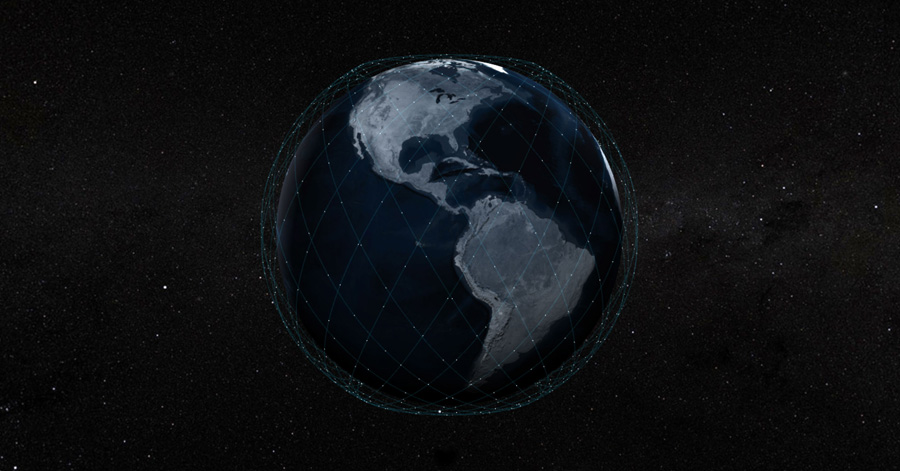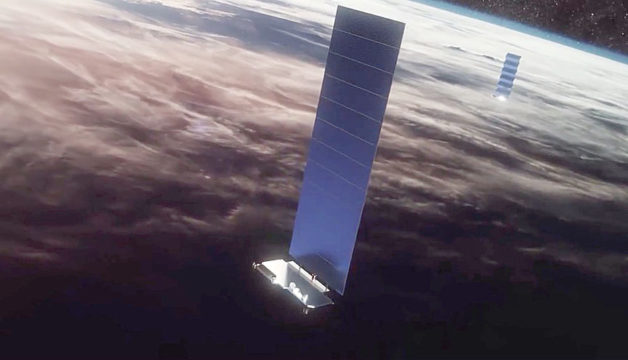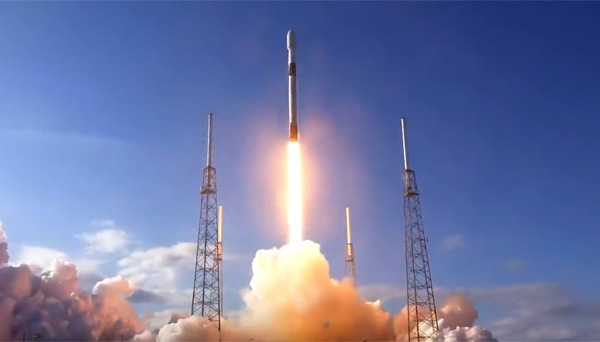As Starlink satellites continue to enter low-Earth orbit — there are 360 of them now — SpaceX is working to mitigate the serious problems they pose for astronomy.

SpaceX
On March 18th, aerospace company SpaceX sent its sixth batch of 60 Starlink satellites into the sky. That brings the total number of Starlinks in low-Earth orbit to 360, putting SpaceX well on its way to having a working network of broadband internet-providing satellites. The company is staying on course to build a preliminary network of 1,584 satellites, and ultimately one that’s 12,000 or even 40,000 strong.
Those numbers throw many astronomers into despair. Satellites in our skies are nothing new — the number has been increasing steadily since the Space Age began. But for the first time, thousands of satellites will be reflecting sunlight from low orbits, making them bright enough to outshine the stars.
One Potential Solution: The DarkSat
Astronomers have voiced their concerns, and SpaceX is listening. They launched a DarkSat (technically identified as Starlink-1130) on January 6th with an “experimental darkening treatment” to reduce the amount of light it reflects.

SpaceX
“Preliminary results show a notable reduction,” said SpaceX engineer Jessica Anderson in a webcast of the most recent launch.
However, observations by Jeremy Tregloan-Reed (University of Antofagasta, Chile) and colleagues using the 0.6-meter Chakana telescope in northern Chile, show that the reduction, while notable, is modest. The results are posted on the astronomy preprint server arXiv.
Using images of satellite tracks taken on March 6th, when the satellite had reached its nominal 550-kilometer altitude and oriented its solar panel to the Sun, the astronomers measured a brightness of 7.6 magnitudes. That’s only slightly fainter than another satellite (Starlink-1113), which came in at 6.7 magnitudes.
A lot of factors come into play when determining how bright a satellite will be, among them the angle between the satellite, the Sun (whose light it’s reflecting), and Earth. The satellites were at a low elevation, putting them farther away from the telescope than they would have been if they were directly overhead. Using a simple calculation, the astronomers found that if directly overhead, the satellites would both be brighter, but the reflective coating would help more: the darkened Starlink would be 0.88 magnitudes, or 55%, fainter than its counterpart.
The upshot is that the experimental darkening could help make the satellite less visible to backyard astronomers, but it won’t do enough to help professional observatories, especially ones set to perform wide-field surveys.
The Vera C. Rubin Observatory being built in Chile will scan the whole night sky every three days. Astronomers and SpaceX alike recognize it as representing one of the observatories most severely impacted by Starlink.
The issue for Rubin Observatory is that a single too-bright satellites not only streaks across an image, but cross-talk effects between detector segments also create multiple fainter echoes of that trail. A single satellite trail thus ruins not just the pixels within the actual trail but significant portions of the image.
Read more about the potential impacts of Starlink and other megaconstellation satellites on astronomy in the March 2020 issue of Sky & Telescope.
The Sun Umbrella
Fortunately, the experimental coating isn’t the only trick up engineers’ sleeves. Another idea, which SpaceX CEO Elon Musk announced March 9th at the Satellite 2020 conference, is to equip each satellite with what amounts to a sun umbrella, shielding the spacecraft from the Sun and thus preventing reflection. However, it’s still unclear what this sunshade would look like or when it would be launched.
“SpaceX has been aggressively pursuing multiple solutions,” says Kelsie Krafton (American Astronomical Society). SpaceX’s incremental approach to manufacturing makes it adaptable, she adds, so that potential solutions can be continually incorporated, tested, and improved upon.
The AAS and the International Astronomical Union (IAU) have been coordinating talks between SpaceX and astronomers around the world. “Every time we talk to [SpaceX], they reveal even more work they are doing on this project,” Krafton says.
Tony Tyson (University of California, Davis), an astronomer with the Rubin Observatory, agrees. “SpaceX is taking this seriously and is committed to solving the problem,” he says. “This is a complex engineering problem.”
So What’s Next?
SpaceX is continuing to roll out its broadband internet plans, having just received Federal Communications Commission (FCC) approval for 1 million Starlink ground stations. And even amid the coronavirus pandemic, another Starlink launch is scheduled for April.

SpaceX
What’s more, on March 30th, SpaceX’s only major competitor, OneWeb, filed for Chapter 11 bankruptcy protection. OneWeb is the only other company with megaconstellation dreams to have actually launched working satellites; the company had already brought 74 of them into low-Earth orbit, most recently on March 21st. Those satellites — and the radio spectrum they’ve claimed — will likely not come down but rather be sold as part of the bankruptcy proceedings. Amazon and several Chinese companies have expressed interest in operating a megaconstellation.
The business of telecom satellites is a risky one that SpaceX CEO Elon Musk acknowledges. Most companies that have attempted it have failed. But so far, it looks like SpaceX is succeeding. As such, the company’s engineers will need to keep hacking away at the problem of how to make their satellites less of an intrusion to the night sky.
 15
15









Comments
Anthony Barreiro
April 7, 2020 at 5:55 pm
Thanks very much for your sober and timely reporting on Starlink. This is the single biggest issue facing astronomy today. It is encouraging to know that SpaceX is taking the problem seriously and working to mitigate the harmful effects of these satellites.
I'm curious how a sunshade would work on a solar-powered satellite. My first thought is that I want some of whatever Elon is smoking. But seriously, how would that work?
You must be logged in to post a comment.
Rick Fienberg
April 9, 2020 at 2:51 pm
The "umbrella" would presumably shade the Earth-facing side of the satellite's body, not the solar panel.
You must be logged in to post a comment.
Anthony Barreiro
April 9, 2020 at 5:28 pm
Thanks Rick. Except when the satellite is directly overhead from an observer's location, the solar panel would still be visible and presumably reflecting sunlight. I guess I would need to see a diagram to understand how (and if) these umbrellas would work.
You must be logged in to post a comment.
Warren-Odom
April 10, 2020 at 5:29 pm
Your comment about being "directly overhead" got me to thinking a bit. One imperfect solution, but guaranteed successful for limited periods, may be to only point the telescope at portions of the sky that are in the earth's shadow (at the proper orbital altitude) at the time. This will cut possible observing time, depending on the sky location of the object of interest, as well as factors like latitude, and the season of the year -- but you won't see any LEO satellites, period. Obviously not great for continuous monitoring of changes in the object, although you might be able to get much better coverage by shifting among observatories as each one rotates into late-nighttime.
You must be logged in to post a comment.
Anthony Barreiro
April 10, 2020 at 6:20 pm
"The Vera C. Rubin Observatory[*] being built in Chile will scan the whole night sky every three days. Astronomers and SpaceX alike recognize it as representing one of the observatories most severely impacted by Starlink."
*This is the Large Synoptic Survey Telescope, aka the canary in the Starlink coalmine.
You must be logged in to post a comment.
Monica YoungPost Author
April 10, 2020 at 9:06 pm
Anthony, "the canary in the Starlink coalmine" is so fitting, I may have to steal it! 😉
You must be logged in to post a comment.
Anthony Barreiro
April 11, 2020 at 2:26 pm
I would be honored! No attribution needed.
You must be logged in to post a comment.
Monica YoungPost Author
April 10, 2020 at 9:07 pm
I agree, I don't quite understand how it would work. But so far SpaceX isn't saying much about technical details, some of which are likely still being worked out.
You must be logged in to post a comment.
Warren-Odom
April 10, 2020 at 5:18 pm
I'm a little skeptical of the umbrella concept. After all, the umbrella itself would reflect some light!
You must be logged in to post a comment.
976herget
April 12, 2020 at 4:15 am
Why don't they just etch the glass of the solar panels so it's more of a flat matte finish versus a smooth reflective surface? It would still gather plenty of light to power it, without the reflectability.
You must be logged in to post a comment.
Keneke
April 10, 2020 at 4:46 pm
Why don't they just make the reflective surfaces adjustable, so the refelected light would could be directed, when needed, away from the earth...
You must be logged in to post a comment.
Elain Moria
April 10, 2020 at 7:05 pm
I wonder if they have considered using Vantablack, or adapting it to use in space. Although as it absorbs light, that may well cause serious overheating issues.
~E
You must be logged in to post a comment.
Anthony Barreiro
April 12, 2020 at 7:14 pm
I have read that spy satellites are painted black, to make them harder to track visually from the ground.
You must be logged in to post a comment.
James Daly, Ph.D
April 11, 2020 at 11:48 am
Aside from the obvious lack of forethought on the part of SpaceX executives (read Elon Musk) and how their project would effect astronomy, there are other troublesome aspects to this dystopian Skynet:
1) That the FCC has granted an operating license to SpaceX for 1 million ground stations!
Where will they be located? A quick calculation of the surface density of 1,000,000 ground nodes and the approximate surface area of the continental US (9.6 M Sq Km), since the FCC's jurisdiction ends at the borders, places one downlink receiver uniformly every 9.6 Km within the lower 48 states. Presumably, the downlink signal will be to support 5G surface broadband and, with the jury still out on the health effects of 5G, is this a good idea?
Starlink will be using both the Ku and Ka bands, presumably observing the conventional uplink and downlink frequency protocols. The uplink and downlink frequencies in the Ka band are 26.5 - 40 Ghz and 12 - 20 Ghz respectively, all in the microwave region of the spectrum! As an aside, 5G partially overlaps the Ka band at 28, 38, and 60 GHz.
The question begs asking: what is the beam width from each satellite at 550 Km altitude? It's probably not that narrow, hence the need for 1 M ground nodes; thus will we be continuously bathed in low-level Ka/Ku microwave-band RF?
2) Radio Astronomy and the ALMA
If SpaceX's proposed rollout is allowed to proceed as planned, the impact to Radio Astronomy could be more far-reaching and much worse than the impact Starlink would have on Optical Astronmy if the engineers at SpaceX don't manage to solve the current satellite reflection problem, in whole or in part.
The data, research, images and results streaming out from ALMA are nothing short of spectacular! As we know, ALMA provides us with the ability to observe and explore the 'Cold Universe'. SpaceX's proposed worldwide coverage by Starlink is a frontal, full-on, direct threat to ALMA and our ability now to observe in the millimeter and sub-millimeter wavebands.
As of now, the low-end of ALMA's observing waveband (350 μm - 10 mm) of 10 mm overlaps with the Ka uplink range of 11.1 mm – 7.5 mm.
With worldwide coverage, the ATACAMA Desert Plateau would be bathed in a continuous, low-level stream of Ka band downlink RF in the 12-20 Ghz range, that's if SpaceX respects those constraints. As an aside, the Kepler Mission used the higher frequency range (11.1 mm – 7.5 mm) to downlink the scientific data collected by the telescope, so these frequency protocols are more of a convention than an enforceable rule. Whose to say what they could decide to do now or later and, with the currect political climate and virtually no government oversight, it's a fools bet to hope that a huge corporation that continues to receive government funding and subsidies to develop low earth orbit like its a piece of real estate would do the right thing and play by the rules.
With Ajit Pai as head of the FCC, the 1 M-Station operating license is no surprise and any impediment to expanding or enhancing the Starlink project would be steamrolled, something not too hard to imagine given that they've greenlighted 5G rollout over the objections of hundreds of doctors and professionals worldwide from many scientific disciplines.
New observing programs and targets below the 10 mm cutoff would forever be impossible at ALMA, even if the low-end wavelength cutoff were extended below 10 mm as the array would be looking upward at a 10+ mm sky much in the same way the CMB looked to Penzias and Wilson.
You must be logged in to post a comment.
Cookie
August 4, 2020 at 5:22 pm
PHEW! I'm so glad that space travel is NO LONGER an environmental disaster! My mind is finally at ease! So glad that Shamazon founder is planning on heading that way also, so that "in the future, millions, billions, trillions of people" will be living on all of the other planets his royal kingship will find. Of course, the 800 million people who are currently without potable water and also are starving to death on this planet can finally be completely forgotten about, along with the non-environmental disaster making space shots with the end result of circling the globe with satellites so those same "losers" can also get telephone and internet service, as well as shop more easily on line from Cramazon when that second ring of surveillance, I mean, special-loving-kindness gets going as well. I'm SO GLAD that none of the earlier comments made in 2019 regarding the sheer stupidity of Starlink itself (see below) needs to ever be addressed again, now that we know about the Magic Umbrella of Destroying-Destruction that is underway. So, people of the internet who thought the following, need never apply their rational minds to this ever again: "It's all OK. We just wait until some space junk from any of these great systems kill a few astro / cosmo nauts and then the outrage will take care of this stupid way of giving everybody on the planet access to social media and the latest stupid human tricks video."; "I imagine a future where a company like Space-X will be selling real estate on the far side of the moon, as the only place to get an unfettered view of the night sky. In my lifetime, the sighting of a satellite will go from a rare and exciting event, demonstrating the fantastic achievements of mankind, to one bringing angst at another form of human engendered pollution robbing away from us what countless generations have enjoyed for millennia.......the majesty of the night sky."; "I remember the thrill of watching for Sputnik and listening to it on my ham receive in the late 50's. Now I capture a satellite in (or should I say a satellite passes through) at least one deepsky image out of 20, or maybe even less depending on the DSO. Fortunately I can take it out with software but 12000 are going to make a helluva mess!"; "Thank God men cannot fly, and lay waste the sky as well as the earth. - Henry David Thoreau". Thanks for the "UPDATE", to the original article: https://skyandtelescope.org/astronomy-news/starlink-space-debris/ that began by stating:
"The Starlink satellites launched by SpaceX two weeks ago have come under heavy criticism for their potential to clutter the sky. Author Jan Hattenbach sat down with Stijn Lemmens, Senior Space Debris Mitigation Analyst at the European Space Agency (ESA) in Darmstadt, Germany, to talk about how Starlink plays into the space junk problem.
Editor’s note: This interview has been lightly edited for grammar, brevity, and to add relevant links.
Jan Hattenbach: The recent launch of the first 60 “Starlink” satellites has sparked outrage on social media. Some critics claim the “mega-constellation” of satellites by the U.S. company SpaceX will increase the risk of creating more space junk, even calling it a threat to space flight itself. What is your opinion — is this criticism justified or exaggerated?" - and on it went, but this new Update puts all my fears to rest. In fact, I can't help but feel like this is really, a really, really terrific people have told me, I don't know but they tell me, thing that is like a miracle in the sky and can put the people on the planets and maybe sell rides like a terrific really great circus up there, I don't know, you tell me, but I see the really great potential for America's greatness being colonized and so many things that it does when it's up there, you don't even know about yet, we have to wait for the astrologers to tell us, maybe soon, I don't know, but it looks very, very, very good.
You must be logged in to post a comment.
You must be logged in to post a comment.